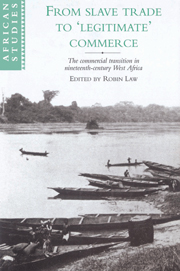 From Slave Trade to 'Legitimate' Commerce
From Slave Trade to 'Legitimate' Commerce Published online by Cambridge University Press: 21 September 2009
One of the central issues of West African history in the anti-slave trade era is the transition from the slave trade to ‘legitimate’ trade. Dahomey, a major exporter of slaves and later of palm oil, has often been used as an illustrative case-study of the problems and implications of that transition. In Dahomey, the reign of King Ghezo, 1818–1858, is of especial significance in this process of the substitution of palm produce exports for slaves.
In fact, Ghezo came to power through a coup d'état with the assistance of a famous slave-trader, the Brazilian Francisco Felix de Souza, at a time when the British were leading an international crusade for the suppression of the Atlantic slave trade. Throughout the forty years of Ghezo's reign, the British relentlessly put pressure on him to give up slaving and human sacrifices, two basic features of Dahomey's history. Though this pressure was resisted, palm oil progressively emerged as Dahomey's major export in place of slaves. Ghezo was therefore able to overcome the ‘crisis of adaptation’ resulting from the change from the slave trade to the palm oil trade, thereby proving, contrary to contemporary philanthropist assumption, that trade in human beings and in agricultural goods were compatible.
In the historiography of nineteenth-century Dahomey, the totality of factors in Ghezo's policy has not hitherto been properly assessed. Beninese scholars have perceived his reign as a turning point in the kingdom's political and economic history for two main reasons.
To save this book to your Kindle, first ensure [email protected] is added to your Approved Personal Document E-mail List under your Personal Document Settings on the Manage Your Content and Devices page of your Amazon account. Then enter the ‘name’ part of your Kindle email address below. Find out more about saving to your Kindle.
Note you can select to save to either the @free.kindle.com or @kindle.com variations. ‘@free.kindle.com’ emails are free but can only be saved to your device when it is connected to wi-fi. ‘@kindle.com’ emails can be delivered even when you are not connected to wi-fi, but note that service fees apply.
Find out more about the Kindle Personal Document Service.
To save content items to your account, please confirm that you agree to abide by our usage policies. If this is the first time you use this feature, you will be asked to authorise Cambridge Core to connect with your account. Find out more about saving content to Dropbox.
To save content items to your account, please confirm that you agree to abide by our usage policies. If this is the first time you use this feature, you will be asked to authorise Cambridge Core to connect with your account. Find out more about saving content to Google Drive.